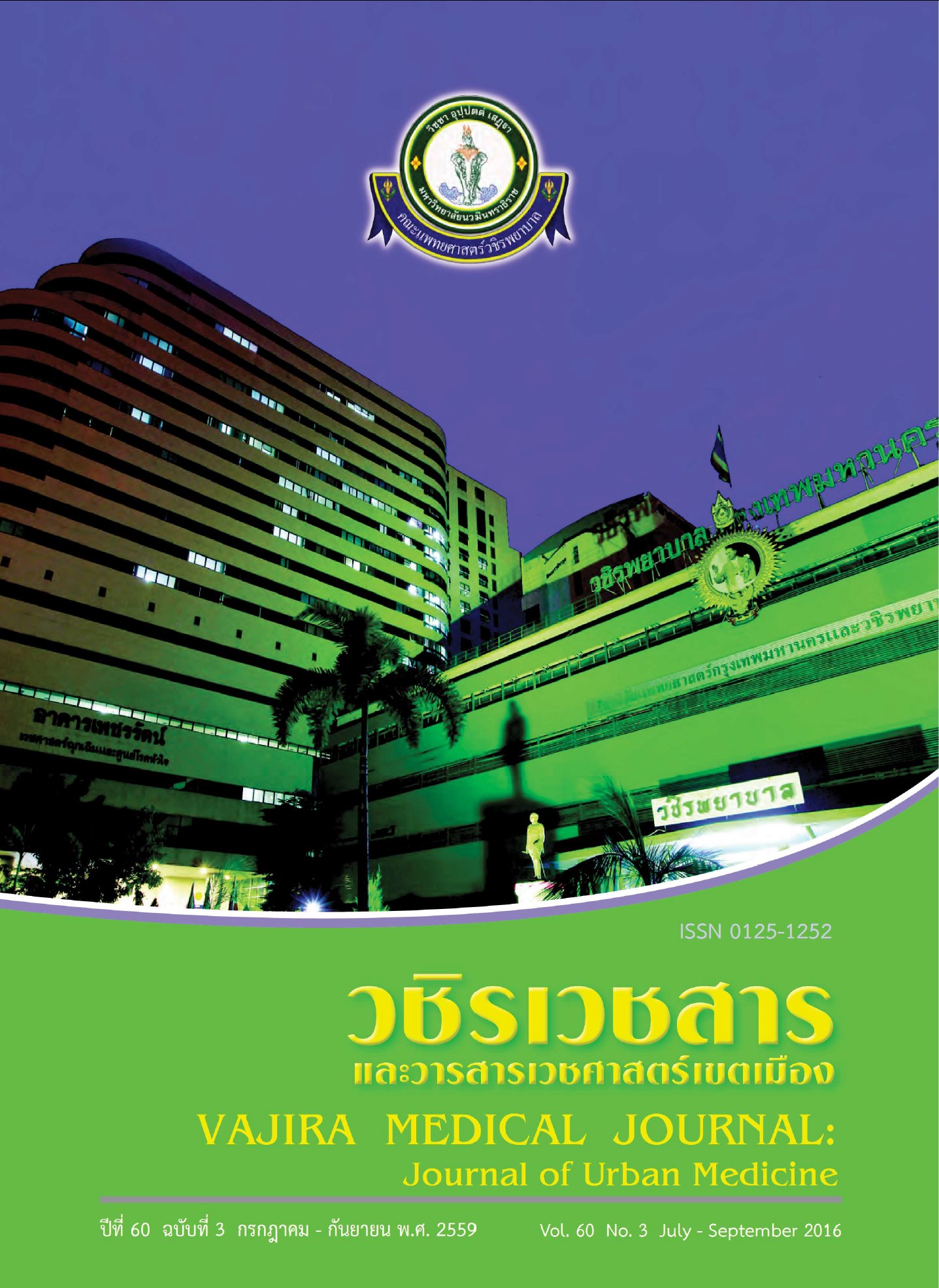Survival Analysis of Time to Amputation Event Data in Patients with Severe Foot Problems in Vascular Practice
Main Article Content
Abstract
Objective: To estimate time to amputation event in patients with severe foot problems in vascular practice and investigate the relationship of factors influencing the amputation event and time of patients with severe foot problems in vascular practice.
Methods: The study design was a retrospective cohort study using data collected from medical records in the Faculty of Medicine Vajira Hospital, Navamindradhiraj University. The study included patients who were diagnosed with patients with severe foot problems in vascular practice (patients who were diagnosed with critical limb ischemia (CLI) and/or diabetic foot) between January 1, 2009 and December 31, 2010, and follow-up times started from January 1, 2009 to December 31, 2014.
Results: There were 372 patients, the follow-up time ranged from 0.066 to 72.933 months (median 50.466 months). There were detected amputation event in 89 of 372 patients (23.9%). The 10th percentiles were 1.66 months. According to Cox’s proportional hazard model, there were 3 significant variables affecting the amputation event rates, that were smoking, HbA1c ≥ 7.5% and presence of renal disease (p-value = 0.034, <0.0001 and 0.021, respectively).
Conclusion: In vascular practice, patients with severe foot problems who smoked, had HbA1c ≥ 7.5% and had renal disease were more prone to have amputation events.
Downloads
Article Details
References
2. Lee ET. Statistical methods for survival data analysis. 2th ed. Hoboken, NJ: John Wiley & Sons, Inc; 1992. p. 8.
3. Kleinbaum DG, Klein M. Survival analysis: A Selflearning text. 2th ed. New York, NY: Springer Science & Business Media, Inc; 2005. p. 4-62.
4. Korosteleva O. Clinical statistics: Introducing clinical trials, survival analysis, and longitudinal data analysis. Burlington, MA: Jones & Bartlett Publishers; 2009. p. 33-59.
5. Dwyer JH, Feinleib M, Lippert P, Hoffmeister H. Statistical model for longitudinal studies of health. New York, NY: Oxford University press; 1992. p.163-209.
6. Morrell CH, Brant LJ. A Two-stage linear mixedeffects/ Cox model for longitudinal data with measurement error and survival. The Biometrics Section of the American Statistical Association2000; 198-203.
7. Fisher LD, Lin DY. Time-dependent covariates in the Cox proportion-hazards regression model. Annu Rev Public Health. 1999; 20: 57-145.
8. Cox DR. Regression Models and Life-Tables. J R Stat Soc. 1972; 34: 187-220.
9. Allie DE, Hebert CJ, Lirtzman MD, Wyatt CH, Keller VA, Khan MH, et al. Critical limb ischemia: a global epidemic. A critical analysis of current treatment unmasks the clinical and economic costs of CLI. EuroIntervention. 2005; 1: 75-84.
10. Engelhardt M, Boos J, Bruijnen H, Wohlgemuth W, Willy C, Tannheimer M, et al. Critical limb ischaemia: initial treatment and predictors of amputation-free survival. Eur J Vasc Endovasc Surg. 2012; 43: 55-61.
11. Mutirangura P, Ruangsetakit C, Wongwanit C, Sermsathanasawadi N, Chinsakchai K. Atherosclerosis Obliterans of the lower extremities in Thai patients. J Med Assoc Thai. 2006; 89: 1612-20.
12. Won SH, Chung CY, Park MS, Lee TS, Sung KH, Lee SY, et al. Risk factors associated with amputation-free survival in patient with diabetic foot ulcers. Yonsei Med J. 2014; 55: 1373-8.
13. Collett D. Modeling survival data in medical research. 2th ed. London: Chapman & Hall/CRC; 1995. p. 253-67. 170 Survival Analysis of Time to Amputation Event Data in Patients with Severe Foot Problems in Vascular Practice ปีที่ 60 ฉบับที่ 3 กรกฎาคม – กันยายน พ.ศ. 2559 วชิรเวชสารและวารสารเวชศาสตร์เขตเมือง Sumittra Muangkhoua, Prasong Kitidamrongsuk, Chukiat Viwatwongkasem, Waigoon Stapanavatr
14. Klomp HM, Steyerberg EW, Wittens CHA, Van Urk H, Habbema JD. A prognostic model for amputation in critical lower limb ischemia. Vasc Med. 2009; 14: 109-15.
15. Yesil S, Akinci B, Yener S. Predictors of amputation in diabetics with foot ulcer: single center experience in a large Turkish cohort. Hormones. 2009; 8: 286-95.
16. Tseng CH. Prevalence and risk factors of diabetic foot problems in Taiwan: A cross-sectional survey of non-type 1 diabetic patients from a nationally representative sample. Diabetes Care. 2003; 26: 3551.
17. Yekta Z, Pourali R, Mezhadrahim R, Ravanyar L, Ghasemi-rad M. Clinical and behavioral factors associated with management outcome in hospitalized patients with diabetic foot ulcer. Diabetes Metab Syndr Obes. 2011; 4: 371-5.
18. Miyajima S, Shirai A, Yamamoto S, Okada N, Matsushita T. Risk factors for major limb amputations in diabetic foot gangrene patients. Diabetes Res Clin Pract. 2006; 71: 272-9.
19. Cheng SW, Ting AC, Lau H, Wong J. Survival in patients with chronic lower extremity ischemia: A risk factor analysis. Ann Vasc Surg. 2000;14(2):158-65.
20. Markowitz JS, Gutterman EM, Magee G, Margolis DJ. Risk of amputation in patients with diabetic foot ulcers: a claims-based study. Wound Repair Regen. 2006; 14: 11-7.
21. Abou-Zamzam AM Jr, Gomez NR, Molkara A, Banta JE, Teruya TH, Killeen JD, et al. prospective analysis of critical limb ischemia: Factors leading to major primary amputation versus revascularization. Ann Vasc Surg. 2007; 21: 458-63.
22. Owens CD, Ho KJ, Kim S, Schanzer A, Lin J, Matros E, et al. Refinement of survival prediction in patients undergoing lower extremity bypass surgery: stratification by chronic kidney disease classification. J Vasc Surg 2007; 45: 944-52.
23. Shojaiefard A, Khorgami Z, Larijani B. Independent risk factors for amputation in diabetic foot. Int J Diabetes Dev Ctries. 2008; 28: 32-7.
24. Biancari F, Arvela E, Korhonen M, Soderstrom M, Halmesmaki K, Alback A, et al. End-stage renal disease and critical limb ischemia: a deadly combination?. Scand J Surg. 2012; 101: 138-43.
25. Zubair M, Malik A, Ahmad J. Incidence, risk factors for amputation among patients with diabetic foot ulcer in a north Indian tertiary care hospital. Foot (Edinb). 2012; 22(1): 24-30.


